
Lewis' Woodpecker Head
"Asyndesmus torquatus. Lewis' Woodpecker. Lared Woodpecker. Adult: Upper parts, including wings and…
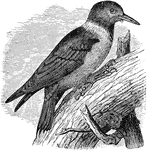
Lewis' Woodpecker
"Asyndesmus torquatus. Lewis' Woodpecker. Lared Woodpecker. Adult: Upper parts, including wings and…
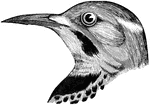
Flicker
"Colaptes auratus. Golden-winged Woodpecker. Pigeon Woodpecker. Flicker. Yucker. High-holder. Back and…
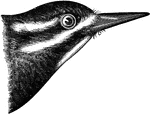
Red-headed Woodpecker
"Sphyropicus thyroides. Brown-headed Woodpecker. Black-breasted Woodpecker. Red-throated Woodpecker.…
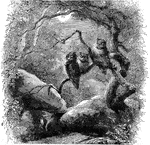
Screech Owls
"Scops. Little Horned Owls. Screech Owls. Like the miniature Bubo in form (all our species under a foot…
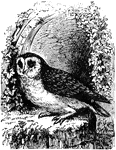
Small Barn Owls
"Aluco flammeus pratincola. Barn Owl. above, including upper surfaces of wings and tail, tawny, fulvous,…
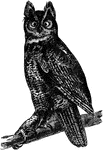
Great Horned Owl
"Bubo virginianus. Great Horned Owl. Hoot Owl. Cat Owl. Distinguished by its large size and conspicuous…
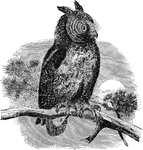
Screech Owl
Scops. Little Horned Owls. Screech Owls. Like the miniature Bubo in form (all our species under a foot…
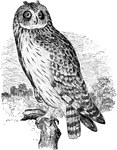
Short-eared Owl
"Asio accipitrinus. Short-eared Owl. Marsh Owl. Ear-tufts inconspicuous, much shorter than middle toe…

Barred Owl
"Strix nebulosa. Barred Owl. Hoot Owl. American Wood Owl. Toes fully feathered, nearly or quite to the…
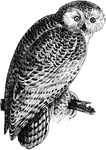
Snowy Owl
"Nyctea scandiaca. Snowy Owl. Pure white, spotted and barred with brownish-black markings, wholly indeterminate…
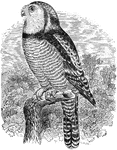
Hawk Owl
"Surnia funerea. American Hawk Owl. Day Owl. Bill and eyes yellow; claws brownish-black. Upper parts…
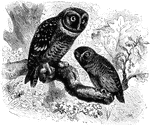
Saw-whet and Sparrow Owls
"Nyctala - Saw-whet Owls. Skull and ear-parts highly unsymmetrical, the the latter of great size, and…
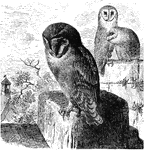
Barn Owls
"Aluco flammeus pratincola. Barn Owl. above, including upper surfaces of wings and tail, tawny, fulvous,…

Burrowing Owl
"Speotyto cunicularia hypogae'a. Burrowing Owl. Adult: Above, dull grayish-brown, profusely spotted…

Marsh Hawk
"Circus cyaneus hudsonius. American Marsh Hawk, Harrier. Blue hawk. Adult Male: In perfect plumage pale…

Harrier Ear Parts
"Circinae. Harriers. Face surrounded with an incomplete ruff (as in most owls); orifice of ear about…
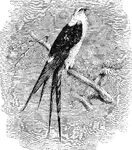
Swallow-tailed Kite
"Elanoides forficatus. Swallow-tailed Kite. Adult: Head, neck, band on rump, and entire under parts,…
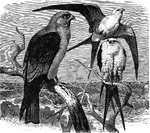
Two Swallow-tail and One Mississippi Kites
Two Swallow-tail and One Mississippi Kite. "Ictinia subcaerulea. Mississippi Kite. General plumage plumbeous…
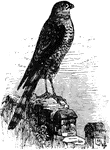
Sharp-shinned Hawk - Small
"Accipiter fuscus. Sharp-shinned Hawk. "Pigeon" Hawk. Above, dark plumbeous, slate-color, or bluish-gray,…
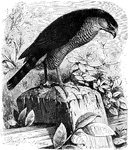
Sharp-shinned Hawk
"Accipiter fuscus. Sharp-shinned Hawk. "Pigeon" Hawk. Above, dark plumbeous, slate-color, or bluish-gray,…
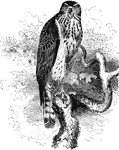
American Goshawk
"Astur atricapillus. American Goshawk. Blue Hen Hawk (adult). Chicken Hawk (young). Adult: Above, dark…
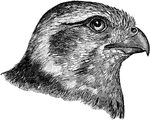
Prairie Falcon Head
"Falco mexicanus. American Lanner Falcon. Prairie Flacon. A medium-sized species, distinguished from…
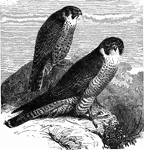
Two Lanner Falcon
"Falco mexicanus. American Lanner Falcon. Prairie Flacon. A medium-sized species, distinguished from…

Falcons
"Falcons. Bill furnished with a sharp tooth and notch near the end of the cutting edge of the upper…

Peregrine Falcon Small
"Falco peregrinus. Peregrine Falcon. Duck Hawk. Great-footed Hawk. A medium-sized falcon, about as large…

Two Peregrine Falcons
"Falco peregrinus. Peregrine Falcon. Duck Hawk. Great-footed Hawk. A medium-sized falcon, about as large…

Common Kestral
Falco tinnunculus. Common Kestral. This bird is a European bird of prey. Plumage on upperside, chestnut-brown…
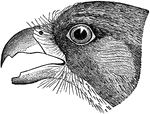
Sparrow Hawk
"Falco sparverius. Rusty-crowned Falcon. Sparrow Hawk. Adults: Crown ashy-blue, with a chestnut patch,…
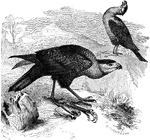
Caracaras
"Polyborus auduboni. Common Caracara. General color blackish, the throat, neck all around, and more…

Red-tailed Buzzard
"Buteo borealis. Red-tailed Buzzard. "Hen Hawk". Upper surface of tail rich chestnut, with white tip…
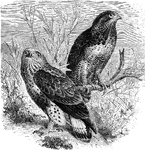
American Rough-legged Buzzard
"Archibuteo lagopus sancti-johannis. American Rough-legged Buzzard. "Black Hawk" Adult: Too variable…

Bald Eagle
"Haliaetus leucocephalus. White-headed Sea Eagle. "Bald Eagle." "Bird of Washington". Adult: Dark brown;…

Osprey
An Osprey catching a fish. "Pandion haliaetus. Fish Hawk. Osprey. Adult. dark vandyke- brown, blackening…
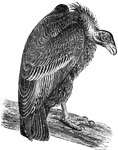
California Condor
"Pseudogryphus californianus. California Condor. Adult: Blackish, the feathers with browner tips or…
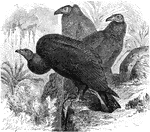
Turkey Buzzard
"Cathartes aura. Turkey Buzzard. Blackih-brown, grayer on the wing-coverts; quills black, ashy-gray…

Passenger Pigeon
"Ectopistes migratorius. Passenger Pigeon. Wild Pigeon Adult: Upper parts, including head all around,…
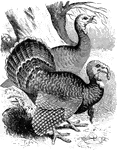
Turkey
"Meleagris gallipavo. Turkey. Upper tail-coverts chestnut, with paler or whitish tips; tail-feathers…

Canada Grouse
"Canace canadensis. Canada Grouse. Spotted Grouse. Spruce Grouse. Spruce "Partridge." Adult: Head smooth,…

Sharp-tailed Grouse
"Pediaecetes phasianellus Columbianus. Common Sharp-tailed Grouse. Upper parts closely and pretty evenly…

White-fronted Dove Details
"Details of Engyptila albifrons (White-fronted Dove); head and foot natural size; wing and tail reduced.
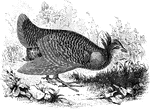
Prairie Hen
"Cupidonia cupido. Pinnated Grouse. Prairie Hen. Above, variegated with black, brown, tawny, or ochrey,…

Ruffed Grouse Head
"Bonasa umbella. Ruffed Grouse. "Partridge;" "Pheasant;" Above, variegate reddish- or grayish-brown,…
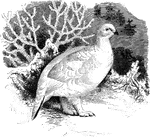
Willow Ptarmigan in Winter
"Lagopus albus. Willow Grouse. Willow Ptarmigan. Bill very stout and convex, its depth at base as the…
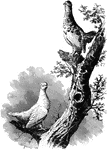
White-tailed Ptarmigan
"Lagopus leucurus. White-tailed Ptarmigan. Rocky Mountain Snow Grouse. Male and Female in winter: Entirely…

European Partridge
"Coturnix. Bill smaller and much slenderer than that of any of the foregoing genera of Odontophorinae;…

Quail Foot and Bill
"Ortyx. Quail. Outstretched feet reaching beyond end of tail. Bill black or blackish-brown. " Elliot…

Ruffed Grouse
"Bonasa umbella. Ruffed Grouse. "Partridge;" "Pheasant;" Above, variegate reddish- or grayish-brown,…

Mountain Quail
"Orortyx picta. Plumed Partridge. Mountain Quail. Back, wings and tail olive-brown, the inner secondaries…
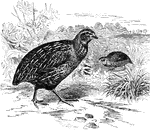
Common Quail of Europe
"Coturnix dactylisonans. Messina Quail. Migratory Quail. Common Quail of Europe. Upper parts variegated…
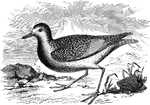
Black-bellied Plover
"Squatarola helvetica. Swiss Plover. Black-bellied Plover. Bull-head Plover. Whistling Field Plover.…
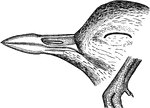
Four-toed Plover Bill and Hind Toe
"Squatarola. Four-toed Plover. A small but distinct hind toe, contrary to the rule in this family. Tail…

English Pheasant
English Pheasant. Common Pheasant. Phasianus colchicus. Adult plumage: Maroon breast, orangey flanks,…

Red Game of Britain
"Lagapus. The densely-feathered feet resemble those of rabbits. No particular feathers on head or neck.…
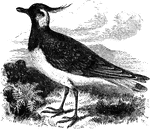
European Lapwing
"The glareoles (Glareolidae) are a remarkable Old World form, like long-legged swallows, wth a cuckoo's…
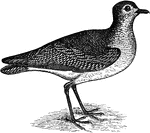
American Golden Plover
"Charadrius dominicus. American Golden Plover. Field Plover. Bull-head Plover. Upper parts black, everywhere…
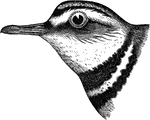
Kildeer Plover
"Aegialites vociferus. Kildeer Plover. Above, grayish-brown, with an olive shade, and in high plumage…
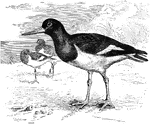
European Oyster-catcher
"Haematopus ostrilegus. European Oyster-catcher. (oyster-opener would b a better name, as oysters do…
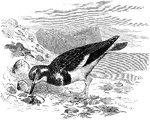
Turnstone
"Strepsilas interpres. Turnstone. Brant Bird. Calico-back. Pied above with black, white, brown, and…

Avocets
"Recurvirostra. Avocets. Bell slender, more or less recurved, then the upper mandible hooked at the…